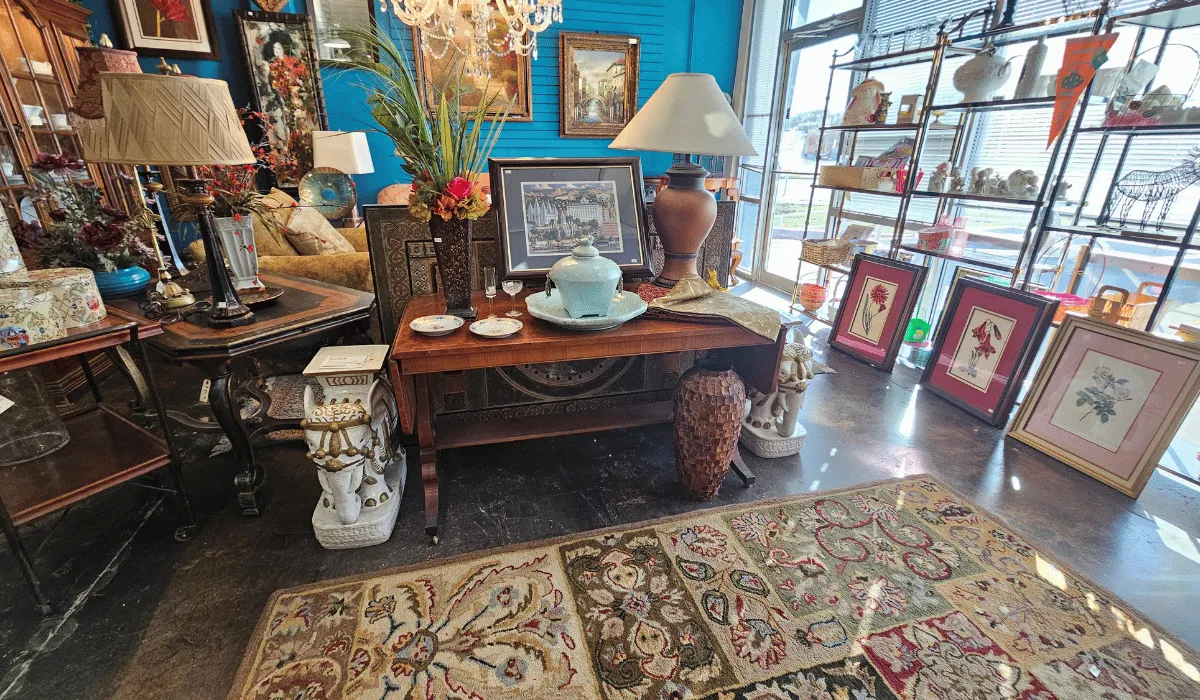
10 Thrifting Tips for Secondhand, Sustainable Home Decor
10 Thrifting tips for stylish and sustainable home decor
Creating a beautiful home doesn’t have to come with a heavy price tag—or a heavy footprint on the planet. By incorporating sustainable home decor, you can design a space that reflects your personality while making eco-friendly choices. One of the best ways to do this is through secondhand home decor. With the right approach and a few smart thrifting tips, you can uncover hidden gems that bring warmth, character, and sustainability into your home. Thrifting is like a treasure hunt where you can find unique items, recycled materials, and sustainably sourced decor that bring character into your living space.
Why choose secondhand home decor?

This sage green credenza is a great example of secondhand furniture that can become a sustainable statement piece.
Shopping secondhand reduces waste, keeps items out of landfills, and often supports local charities or community programs. Beyond sustainability, pre-loved pieces often have more personality than mass-produced items you’ll find in big-box stores. Whether it’s a vintage lamp, a mid-century chair, or a quirky handmade vase, each piece carries its own story. Unlike fast fashion home brands, secondhand home decor often uses sustainable materials that last longer, helping reduce carbon emissions and household waste.
10 thrifting tips for sustainable home decor
1. Be prepared before you shop
Bring a tape measure, a shopping list, and wear comfortable shoes. Knowing your space and needs ahead of time will save you from buying items that don’t fit your home. Think about sustainable practices when you shop—bringing reusable bags, wearing comfortable clothing, and having a list can help you stay focused on eco friendly choices.
2. Explore the right locations

The sale sign illustrates the benefit of finding good deals and discounts.
Thrift stores near higher-income neighborhoods often have well-kept, stylish donations. But don’t overlook smaller, out-of-the-way secondhand shops—they sometimes have the most unique treasures. Check flea markets, estate sales, or small businesses as well—these places often have amazing decor items and vintage textiles you won’t find in big-box stores.
3. Shop at the right time
Go early in the day or mid-week, when stores are quieter and freshly stocked. Avoid weekends when stores can be crowded and picked over. Many stores restock throughout the week, so visiting on quieter days increases your chances of finding unique items and saving money.
4. Ask about discounts

Checking price tags and discount days can pay off.
Many thrift shops offer weekly color-tag sales, loyalty cards, or app-based coupons. These deals can save you up to 50% or more. These thrifting tips are also a great way to support sustainability because buying affordable, secondhand home decor keeps new products from being overproduced.
5. Keep a running list
Stay focused by writing down what you’re looking for—mirrors, baskets, textiles, or furniture—so you don’t get overwhelmed. Having a list ensures you won’t get distracted by clothing or fashion items when your goal is to shop for sustainable home decor for your space.
6. Hunt for statement pieces

Blue and green bottles are unique, eye-catching pieces and the white ceramic bowl is another thrifted statement piece.
Look for items that add character: vintage mirrors, ceramic vases, woven baskets, or textured textiles. These instantly elevate your sustainable home decor. Look for wall art, vintage frames, or handmade ceramics—these decor items add style and personality without the harmful chemicals sometimes found in mass-produced pieces.
7. Think beyond original purpose

Woven baskets are versatile, practical, and stylish for storage or decor.
Get creative. A glass pitcher can double as a vase, a side table can be repurposed as a nightstand, and old curtains can be turned into pillow covers. With a little creativity, even cheap or mismatched textiles, curtains, or knick knacks can be repurposed into stylish, eco friendly home decor.
8. Inspect quality carefully

Fragile items such as crystal and glass must always be examined closely before purchasing.
Secondhand doesn’t mean settling for damaged goods. Check for cracks, stains, or weak joints. Some flaws can be fixed with paint, polish, or upholstery. Check for broken parts or weak joints in furniture and avoid items treated with harmful chemicals. Choosing recycled or natural materials is always a safer bet.
9. Place items in your cart to decide later
If something catches your eye, keep it with you until you’re sure. Thrift store treasures don’t last long—once it’s gone, it’s gone. This approach is especially helpful when the store has a large selection of decor items—you can sort through them later to pick the best sustainable finds.
10. Focus on core categories

Wooden furniture, frames and textiles are strong secondhand buys.
For timeless secondhand home decor, prioritize:
Artwork and frames (repaint or swap the art)
Mirrors with vintage charm
Glassware, ceramics, and pottery
Woven baskets and boxes
Unique lamps and light fixtures
Textiles like blankets and curtains
Solid-wood furniture worth refinishing
Furniture, textiles, and art are some of the best investments in secondhand home decor. These pieces are durable, affordable, and often sustainably sourced.
The bigger impact of thrifting

Secondhand finds can be transformed into cozy, curated, sustainable home decor.
Every secondhand purchase reduces demand for fast furniture and disposable decor. By following these thrifting tips, you’re not just decorating your home—you’re supporting sustainable living. The result? A space that feels personal, budget-friendly, and eco-conscious.
Sustainable decorating isn’t about perfection—it’s about making mindful choices. Next time you’re looking to refresh your space, skip the showroom and head to a thrift store instead. Your home (and the planet) will thank you.
By supporting thrift stores, flea markets, and small businesses, you’re not only saving money but also helping reduce waste and promote sustainability around the world.


